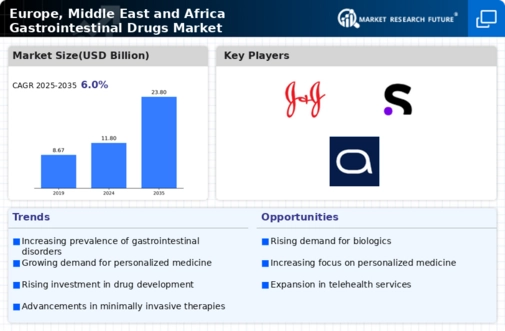Europe Gastrointestinal Drugs Size
Europe Gastrointestinal Drugs Market Growth Projections and Opportunities
Disease Prevalence and Demographics: The prevalence of gastrointestinal diseases in Europe, the Middle East, and Africa has a major impact on the market for GI medications in these regions. The need for efficient GI drugs is influenced by a number of factors, including changing food preferences, lifestyle modifications, and aging populations. Healthcare Infrastructure: The market for GI medications is heavily influenced by the caliber and accessibility of the healthcare infrastructure. Better diagnosis and treatment of gastrointestinal problems can be achieved in developed European countries thanks to their strong healthcare systems. Still, in other regions of Africa and the Middle East, inadequate healthcare infrastructure may hinder market expansion. Regulatory Environment: Strict regulatory frameworks apply to the pharmaceutical industry, which includes GI medicines. The observance of laws established by health authorities in Europe, the Middle East, and Africa has an impact on pharmaceutical firms' market entrance tactics, approval procedures, and medication development. Economic Factors: The market for gastrointestinal pharmaceuticals is influenced by a number of economic factors, such as GDP growth, healthcare spending, and medication affordability in the area. Economic downturns may impact market dynamics on patients' access to and affordability of pharmaceuticals. Patient Education and Awareness: One important consideration is the general public's degree of knowledge and awareness regarding gastrointestinal health. The need for GI medications is fueled by patient education programs, awareness campaigns, and the work of medical professionals in promoting early diagnosis and treatment. Technological Developments in Medicine: The diagnosis and management of gastrointestinal problems are impacted by developments in medical technology, including imaging methods and diagnostic instruments. Personalized medicine, medication delivery methods, and formulation innovations all support market expansion and competitiveness. Cultural and food Influences: The incidence of gastrointestinal illnesses is influenced by a variety of cultural customs and food habits across Europe, the Middle East, and Africa. Pharmaceutical firms must take into account cultural issues that impact treatment adherence and modify medications to fit local food habits.







Leave a Comment